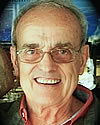 Léo F. Laporte |
2015 Mary C. Rabbitt History And Philosophy of Geology Award
Presented to LÉo F. Laporte
Citation by Stephen M. Rowland
It is my great honor and sincere pleasure to be the citationist for this year’s Mary C. Rabbitt awardee, Léo F. Laporte. Léo was my PhD advisor and mentor at the University of California, Santa Cruz in the 1970s, where he showed me by example that it is possible—and, indeed, it is intellectually satisfying—to be simultaneously engaged in cutting-edge geologic research and research into the history of geology.
Léo received his Bachelor’s and Ph.D. degrees from Columbia University. His Ph.D. research involved a paleontological and carbonate sedimentological study of the Lower Devonian Manlius Formation in upstate New York. After graduating from Columbia, Léo spent 12 years on the faculty at Brown University, followed by 27 years at U.C. Santa Cruz.
We are honoring Léo today primarily for his body of insightful work on the vertebrate paleontologist George Gaylord Simpson, who is often considered to have been the most influential paleontologist of the twentieth century. I was a graduate student of Léo’s when he was just beginning his work on Simpson, and I remember when he returned from a trip to Tucson where he had met with Simpson and his wife Anne Roe. I remember Léo telling me that he had accomplished his goal of establishing a trusting relationship with Simpson and his wife, setting the stage for his later access to Simpson’s personal papers. Léo went on to edit and publish Simple Curiosity: Family Letters of George G. Simpson in 1987, as well as many journal articles about Simpson and the influence of his work. The culmination of Léo’s analysis of Simpson was his Columbia University Press book George Gaylord Simpson: Paleontologist and Evolutionist, published in 2000.
I will close this brief citation on a personal note. In the acknowledgments of Léo’s 2000 book, he thanks two of his colleagues—Ken Taylor and Hugh Torrens—“who by their example and enthusiasm for the history of geology aided me in raising my own standards and staying the course.” I take this opportunity to acknowledge and thank my mentor, Léo Laporte, for his example and enthusiasm for the history of geology which has aided me in raising my own standards and staying the course.
 2015 Mary C. Rabbitt History And Philosophy of Geology Award — Response by LÉo F. Laporte
2015 Mary C. Rabbitt History And Philosophy of Geology Award — Response by LÉo F. Laporte
I welcome this opportunity to thank my campaign managers, Ken Taylor and Ken Bork, themselves past Rabbitt awardees, for bringing my award about after two previous, unsuccessful attempts. I also thank the Award Committee for eventually seeing the light, and the late Mary C. Rabbitt for making it possible in the first place.
I must also acknowledge my two paleontological mentors, the late Norman Newell and John Imbrie, who both provided distinguished professional examples and in whose long shadow I hobble, still looking over my shoulder.
And my very warm, special thanks to Steve Rowland for his eloquent citation just now. I’ve been closely associated with Steve since his graduate days at Santa Cruz, and I’m honored he took up this challenge when asked.
One benefit of reaching seniority is the opportunity to think about what has fundamentally motivated one’s life. My early religious instruction introduced me to the rote learning of the question-and-response of the Catholic Catechism. First question: Who made the world? Second question: Why did He make the world? Unconvinced by such puzzling claims, it wasn’t until college courses in geol0gy and astronomy that I arrived at answers that addressed not who started the world and why, but rather how it started, and evolved through time.
Thus, one of the two motifs that has long intellectually motivated me is epistemology that branch of philosophy that deals with the origin and evidentiary basis of knowledge. Consequently, like Darwin and Simpson, my religious faith slowly evaporated, leaving me with a rational, atheistic world view.
The source of the second, life-motivating motif is less clear to me. But soon after college, the easiest way I found to express myself was by writing and teaching. As an academic I enjoyed writing historical non-fiction, whether situated in narratives of environmental geology, marine paleoecology, organic evolution, Darwin, or Simpson. And now in retirement I have moved on to short autobiographical essays.
The two threads—epistemology and written exposition—have their source in specific, reasonably established facts stitched together in a narrative that, I hope, exhibits “unity, coherence, and proportion,” the three essential criteria I learned in high school essay-writing from Mr. Connolly.
I’ll close with a quote from Harriet Martineau, mid-19th century English social theorist, often cited as the first female sociologist. She was writing about herself, but I believe —or at least hope—what she says could be equally applied to me. So, using her words as my own, “[My] original power was nothing more than was due to earnestness and intellectual clearness within a certain range. With small imaginative and suggestive powers, and therefore nothing approaching genius, [I] could see clearly what [I] did see, and give a clear expression to what [I] had to say. In short, [I] could popularize while [I] could neither discover nor invent.”
Again, thanks to everyone who had anything to do with the award—whether for or against. I truly appreciate it.
